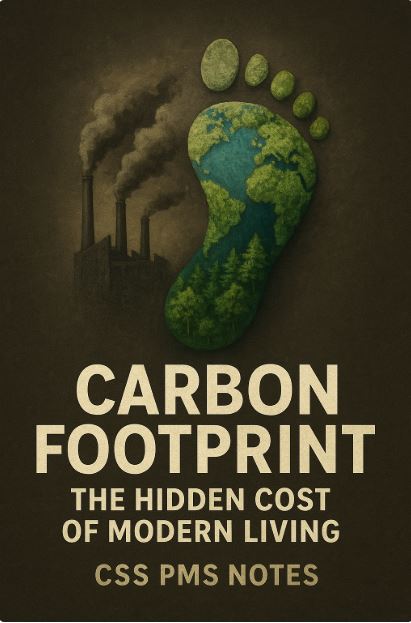Carbon Footprint: The Hidden Cost of Modern Living

Every click, every drive, and even your morning coffee leaves a mark — an invisible trace known as your carbon footprint. In a world racing toward sustainability, understanding and reducing our carbon footprint isn’t just a choice — it’s a responsibility.
What is a Carbon Footprint?
A carbon footprint refers to the total amount of greenhouse gases (GHGs) — primarily carbon dioxide (CO₂) and methane (CH₄) — released into the atmosphere as a result of human activities.
These emissions come from:
- Energy use (electricity, gas, oil)
- Transportation (cars, planes, ships)
- Food production (especially meat and dairy)
- Manufacturing and waste management
In simple terms:
Your carbon footprint measures how much you contribute to global warming.
How is a Carbon Footprint Measured?
Carbon footprints are usually measured in tons of CO₂-equivalent (CO₂e) per year. This unit combines different greenhouse gases into one comparable measure.
| Activity | Approximate Emissions (CO₂e) |
|---|---|
| 1 gallon of gasoline burned | 8.9 kg CO₂ |
| 1 flight (New York to London, round trip) | 1.6 tons CO₂ |
| 1 kWh of electricity (US average) | 0.4 kg CO₂ |
| 1 kg of beef produced | 27 kg CO₂ |
(Source: U.S. Environmental Protection Agency, University of Michigan)
Types of Carbon Footprints
1. Personal Carbon Footprint
This includes your daily lifestyle activities like:
- Commuting
- Energy consumption at home
- Food choices
- Shopping habits
2. Corporate Carbon Footprint
Businesses emit CO₂ through:
- Industrial processes
- Product manufacturing
- Supply chain operations
- Business travel
3. National Carbon Footprint
Countries measure their total emissions to track climate goals.
For instance, the U.S., China, and India are among the world’s largest emitters.
Main Sources of Carbon Emissions
- Transportation: Cars, planes, and shipping collectively produce about 24% of global CO₂ emissions.
- Energy Production: Coal and oil power plants are the largest single sources.
- Agriculture: Livestock releases methane, while fertilizers emit nitrous oxide.
- Industry: Cement and steel manufacturing release billions of tons of CO₂ yearly.
- Deforestation: Cutting trees removes natural carbon sinks.
How Carbon Footprints Affect the Planet
A high carbon footprint directly contributes to:
- Global warming — increasing Earth’s temperature
- Rising sea levels — melting glaciers and polar ice
- Extreme weather — floods, droughts, and hurricanes
- Loss of biodiversity — habitats destroyed by climate change
According to NASA and the IPCC (Intergovernmental Panel on Climate Change):
If global temperatures rise above 1.5°C, catastrophic environmental changes may become irreversible.
How to Calculate Your Carbon Footprint
You can use carbon footprint calculators provided by:
These tools consider:
- Energy use
- Transportation habits
- Food and diet
- Waste and recycling
After calculation, you get a clear picture of your annual emissions and can plan reductions.
How to Reduce Your Carbon Footprint
Here are 10 practical steps for individuals and organizations:
1. Drive Less or Go Electric
- Use public transport or carpool
- Switch to electric or hybrid vehicles
2. Save Energy at Home
- Use LED bulbs
- Turn off unused appliances
- Insulate walls and windows
3. Choose Renewable Energy
- Install solar panels
- Opt for green electricity plans
4. Eat More Plants
- Reduce red meat consumption
- Support local and organic farming
5. Recycle and Reuse
- Separate waste properly
- Avoid single-use plastics
6. Fly Smarter
- Take direct flights
- Offset emissions using airline carbon programs
7. Shop Responsibly
- Buy long-lasting products
- Support eco-friendly brands
8. Go Digital
- Reduce paper use
- Use cloud-based solutions
9. Conserve Water
- Fix leaks
- Install water-efficient taps
10. Support Reforestation
- Plant trees
- Donate to forest protection projects
Carbon Neutrality and Net-Zero Goals
Many countries and corporations are now pledging to achieve net-zero emissions — balancing the amount of carbon emitted with the amount removed.
Examples:
- European Union: Net-zero by 2050
- United States: 50–52% reduction by 2030
- Google & Microsoft: Already carbon neutral
Carbon offsetting (like funding forest restoration or renewable projects) is a major strategy in achieving neutrality.
Future of Carbon Management
The future depends on innovation, awareness, and policy.
New technologies like:
- Carbon capture and storage (CCS)
- Green hydrogen
- Smart grids
are leading the fight against emissions. The Paris Agreement (2015) remains the world’s strongest collective effort, aiming to keep global warming below 2°C.
Conclusion: Every Step Counts
Reducing your carbon footprint may seem small, but when billions of people make changes, the impact is global.
It’s not about perfection — it’s about progress.
Start today, and your simple acts will protect the planet for generations.
FAQs
1. What is the main cause of a large carbon footprint?
The main cause is energy use from fossil fuels — especially transportation, heating, and industrial activities.
2. How can I check my personal carbon footprint?
You can calculate it using online tools like The Nature Conservancy or EPA Carbon Calculator.
3. What’s the difference between carbon neutral and net-zero?
Carbon neutral means offsetting emissions; net-zero means cutting them to near zero and removing the rest.
4. Which countries have the largest carbon footprints?
China, the United States, and India are currently the top three emitters.
For